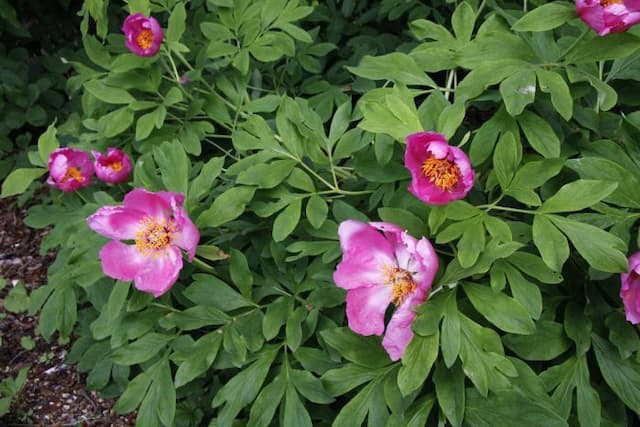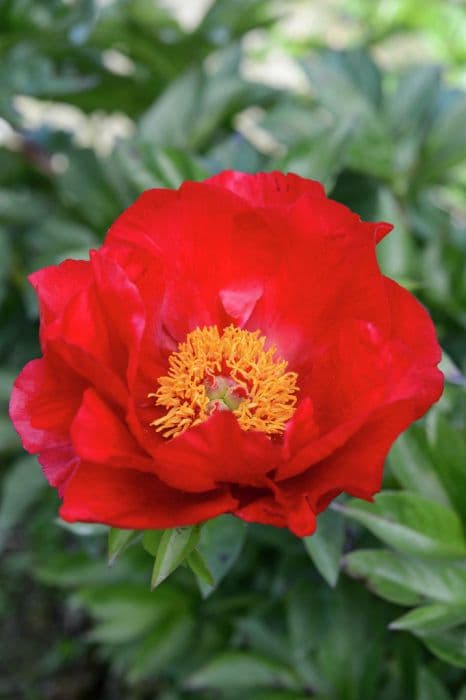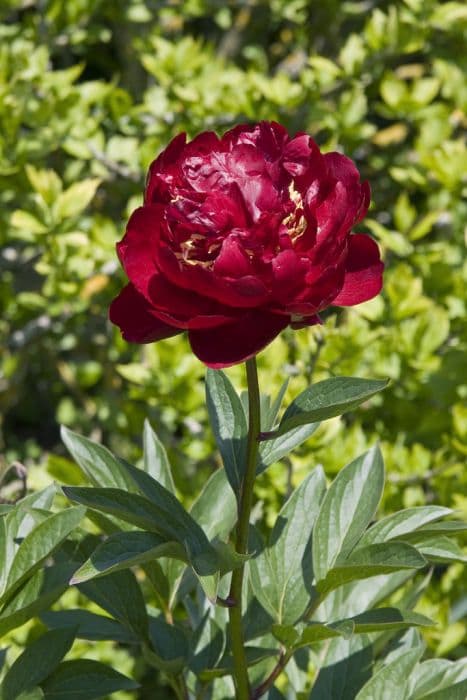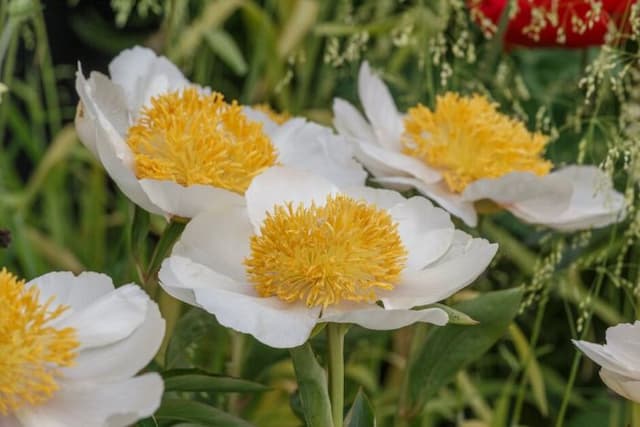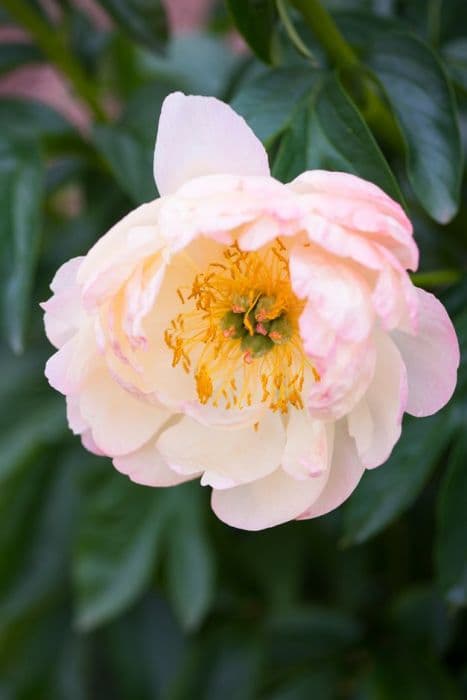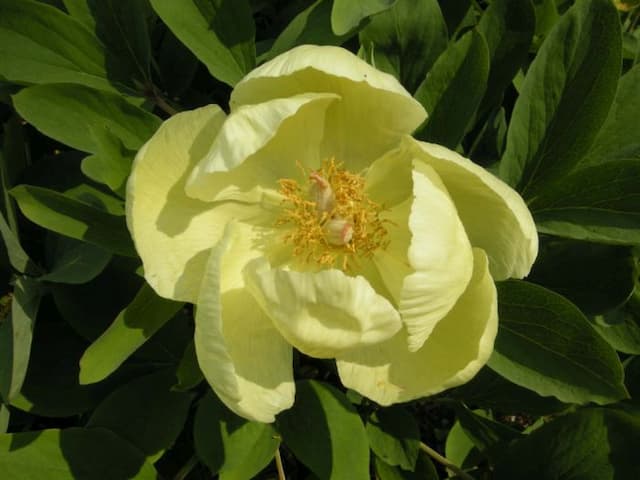Chinese Peony Paeonia lactiflora 'Wladyslawa'
ABOUT
Paeonia lactiflora 'Wladyslawa', commonly known as the Chinese peony, is a perennial plant with a visually striking appearance. This variety of peony is characterized by its lush, deep green foliage that serves as a backdrop for its captivating blooms. The flowers are typically large and double-form, boasting numerous layers of silky petals. The petals display a delicate shade of pink that can range from soft pastel hues to a more vibrant pink, depending on the particular plant and growing conditions. The center of the Chinese peony's bloom is often a slightly deeper pink or may have a hint of yellow from the stamens that can be seen amidst the profusion of petals. As the flowers mature, they can sometimes fade to a lighter pink, creating a charming gradient effect. Furthermore, when the plant is in full bloom, the flowers emit a pleasant fragrance that can attract pollinators and is often enjoyed by gardeners and passersby alike. As a perennial, the Chinese peony dies back to the ground level during the winter months, only to re-emerge in the spring with renewed vigor. Its stems are sturdy, supporting the heavy blooms without much need for staking. The leaves of the plant are also noteworthy, as they are broad, with a rounded shape and a shiny surface, adding to the plant's overall lush and robust appearance. The Chinese peony's beauty makes it a popular choice for ornamental gardens and is often used in cut flower arrangements thanks to its striking flowers and fragrance.
About this plant
 Names
NamesFamily
Paeoniaceae
Synonyms
Chinese Peony, White Peony
Common names
Paeonia lactiflora, Paeonia albiflora, Paeonia edulis.
 Toxicity
ToxicityTo humans
The common name for Paeonia lactiflora 'Wladyslawa' is peony. Peonies are generally considered to have a low level of toxicity to humans. Ingesting parts of the plant, especially in large quantities, may cause mild gastrointestinal upset, including nausea, vomiting, and diarrhea. It is recommended to avoid consuming any part of the peony plant due to these potential effects.
To pets
The common name for Paeonia lactiflora 'Wladyslawa' is peony. Peonies are considered to be mildly toxic to pets, such as dogs and cats. If a pet ingests parts of a peony, it may experience mild gastrointestinal upset, including symptoms such as vomiting, diarrhea, and sometimes lethargy. If a pet consumes a significant amount of the plant, it is advisable to consult with a veterinarian. However, severe poisoning from peonies is uncommon in pets.
 Characteristics
CharacteristicsLife cycle
Perennials
Foliage type
Deciduous
Color of leaves
Green
Flower color
Pink
Height
2-3 feet (60-90 cm)
Spread
2-3 feet (60-90 cm)
Plant type
Herb
Hardiness zones
3-8
Native area
Asia
Benefits
 General Benefits
General Benefits- Aesthetic Appeal: The Paeonia lactiflora 'Wladyslawa', commonly known as the Chinese peony, is highly prized for its large, fragrant flowers that add beauty and elegance to gardens and landscapes.
- Variety of Colors: This plant produces blooms in a range of colors, which can include shades of pink, red, and white, providing a variety of options for garden color schemes.
- Seasonal Interest: Chinese peonies have a distinct blooming season in spring, offering a burst of color after a long winter and creating seasonal interest in the garden.
- Attracts Pollinators: The large, showy flowers of the Chinese peony attract bees and other pollinating insects, which are beneficial for the health of the garden and the environment as a whole.
- Longevity: Peonies are known for their long lifespan, often living for decades and providing a long-term presence in the garden without the need for regular replanting.
- Cut Flower Usage: The blooms of the Chinese peony make excellent cut flowers, holding up well in vases and floral arrangements, extending their beauty indoors.
- Drought Tolerance: Once established, peonies are moderately drought tolerant, reducing the need for frequent watering and maintenance.
- Cold Hardiness: Chinese peonies are cold hardy, enabling them to thrive in cooler climates and return year after year.
- Minimal Pest Problems: They generally have few issues with pests, making them a low-maintenance option for gardeners.
 Medical Properties
Medical Properties- Anti-inflammatory: Paeonia lactiflora has been traditionally used to reduce inflammation.
- Analgesic: It may have mild pain-relieving properties.
- Immunomodulatory effects: Some studies suggest it can modulate the immune system.
- Antioxidant: The plant contains compounds that may act as antioxidants.
- Neuroprotective effects: There is some evidence that it might have a protective effect on the nervous system.
- Antispasmodic: Paeonia lactiflora may be used to alleviate muscle spasms.
 Air-purifying Qualities
Air-purifying QualitiesThis plant is not specifically known for air purifying qualities.
 Other Uses
Other Uses- Paeonia lactiflora 'Wladyslawa', commonly known as Chinese peony, can be used as a natural dye, providing shades of pink or light red when used to dye fabrics.
- In some cultures, the petals of the Chinese peony are used to impart a delicate fragrance to the water during a bath, creating a luxurious and relaxing experience.
- Chinese peony petals can be added to potpourri mixtures, contributing a subtle floral scent and enhancing the visual appeal with their colors.
- The plant can serve as a source of nectar and pollen for beneficial insects in the garden, such as bees and butterflies, supporting biodiversity.
- Used as a floral motif in art and design, the Chinese peony symbolizes beauty and is often included in paintings, embroidery, and decorative objects.
- The blossoms can be crystallized and used as edible decorations on cakes and desserts, giving them an elegant and unique finish.
- The leaves of the Chinese peony, when dried, can be incorporated into handmade paper, providing texture and floral elements to the paper's appearance.
- Chinese peony flowers can be used in photography, often serving as a popular subject for macro photography due to their intricate details and vibrant colors.
- They can be used in crafting pressed flower art, preserving the beauty of the blooms within glass frames or encased in resin jewelry.
- As a traditional symbol of good fortune and prosperity, Chinese peony plants are sometimes planted near homes as a form of feng shui, believed to attract positive energy.
Interesting Facts
 Feng Shui
Feng ShuiThe Peony is often used in Feng Shui practice as a symbol of beauty, romance, and prosperity. It is recommended to place peonies in the southwest area of a garden or home to boost love and marriage luck. In a bedroom, however, peonies should be used with caution as they can promote affairs outside of marriage if placed there.
 Zodiac Sign Compitability
Zodiac Sign CompitabilityThe Peony is not used in astrology practice.
 Plant Symbolism
Plant Symbolism- Prosperity: Peonies like Paeonia lactiflora 'Wladyslawa' are often associated with wealth and success, especially in Eastern cultures where they are a popular symbol during celebratory occasions such as weddings and Lunar New Year.
- Romance: With its lush, full blooms, the peony is frequently regarded as a symbol of romance and love, often used in bridal bouquets and declarations of affection.
- Beauty: The peony's attractive flowers make it a symbol of beauty in various cultures, representing the ideal of feminine allure and charm.
- Honor: Peonies carry a connotation of honor and high esteem, representing noble virtues and respectability.
- Good Fortune: In traditional symbolic language, peonies are considered to be a good omen for a positive future, bringing in good luck and fortune to those who receive or grow them.
- Happiness: The bright and beautiful blooms of the peony are often seen as an embodiment of happiness and joy, making them a popular gift to convey cheerful wishes.
- Healing: Historically, peonies were used for their medicinal properties, symbolizing healing and the soothing of physical and emotional pain.
 Water
WaterPeonies like Paeonia lactiflora 'Wladyslawa', commonly known as common garden peony, require consistent moisture, especially during the growing season. Water them deeply once a week, providing about 0.5 to 1 inch of water which equates to approximately 0.9 to 1.8 gallons per square yard of soil. The goal is to keep the soil moist but not waterlogged. During the hot summer months, you may need to water more frequently to maintain the moisture level. It's important to water the plant at its base to keep the foliage dry and prevent fungal diseases.
 Light
LightThe common garden peony flourishes in full sun to light shade. They perform best when planted in a location that receives at least six hours of direct sunlight each day. Avoid deep shade areas, as this can reduce flowering and weaken the plant over time. The ideal spot for a garden peony is one with morning sunlight and afternoon shade, especially in regions with hot summers, to protect them from scorching.
 Temperature
TemperatureGarden peonies thrive in a temperate climate with winter chill. They typically can survive winter temperatures as low as -20°F and summer temperatures up to 90°F. However, the ideal growing temperature for peonies like Paeonia lactiflora 'Wladyslawa' is between 65°F and 75°F. They need a period of winter cold (below 40°F) to set buds for the next season, so they might not perform well in regions with mild winters without a distinct cold period.
 Pruning
PruningPrune common garden peonies to remove spent flower heads after blooming to promote plant health and prevent seed formation, which can sap energy from the plant. In late fall, after the first frost, cut back the foliage to ground level to help prevent overwintering diseases. Pruning is typically done annually, at the end of the growing season, but dead or damaged stems can be removed at any time. The best time for major pruning is in the fall after the leaves have died back.
 Cleaning
CleaningAs needed
 Soil
SoilThe best soil mix for Chinese Peony (Paeonia lactiflora 'Wladyslawa') should be rich, fertile, and well-draining with a pH of 6.5 to 7.0. A mixture of loamy garden soil, compost, and perlite or sand can provide the necessary drainage and nutrients.
 Repotting
RepottingChinese Peony typically does not require frequent repotting and prefers to be left undisturbed. It should only be repotted if it outgrows its container or every few years to replenish the soil.
 Humidity & Misting
Humidity & MistingChinese Peonies prefer average humidity levels and can thrive in the humidity typically found in outdoor garden settings; they do not require special humidity conditions.
 Suitable locations
Suitable locationsIndoor
Ensure bright light, cool temps, avoid heat sources.
Outdoor
Full sun, well-drained soil, protect from strong winds.
Hardiness zone
3-8 USDA
 Life cycle
Life cyclePaeonia lactiflora 'Wladyslawa', commonly known as Chinese peony, begins its life cycle when the seeds germinate, usually in the autumn, to develop into small seedlings with a primary root system. The seedlings then enter a period of dormancy during the winter months. In spring, the plant resumes growth, producing a stem and a set of leaves, entering the vegetative stage which is followed by the development of flower buds. By late spring to early summer, the buds bloom into the characteristic large, fragrant flowers that peonies are known for. After flowering, the plant sets seeds that mature by late summer, when the above-ground portion begins to die back as the plant enters another dormancy period. The cycle repeats each year, with peonies being perennial plants that can live for many years once established.
 Propogation
PropogationPropogation time
Early Spring
The most popular method of propagation for the Paeonia lactiflora 'Wladyslawa', commonly known as the Chinese peony, is by division. This process is best carried out in the fall after the plant has become dormant. To propagate by division, carefully dig around the plant to lift the root ball out of the ground, minimizing damage to the roots. Wash the soil off the roots so that the eyes, or growth nodes, are visible. Using a sharp knife, divide the root clump into sections ensuring that each section has at least three to five eyes. The divisions can then be replanted at the same depth they were growing before, spacing them about 3 feet (approximately 0.91 meters) apart to allow for growth. Proper watering and care will help establish the new plants.
